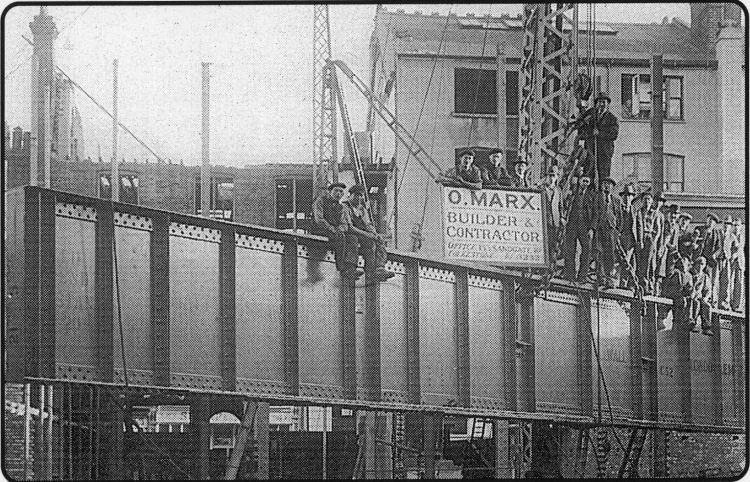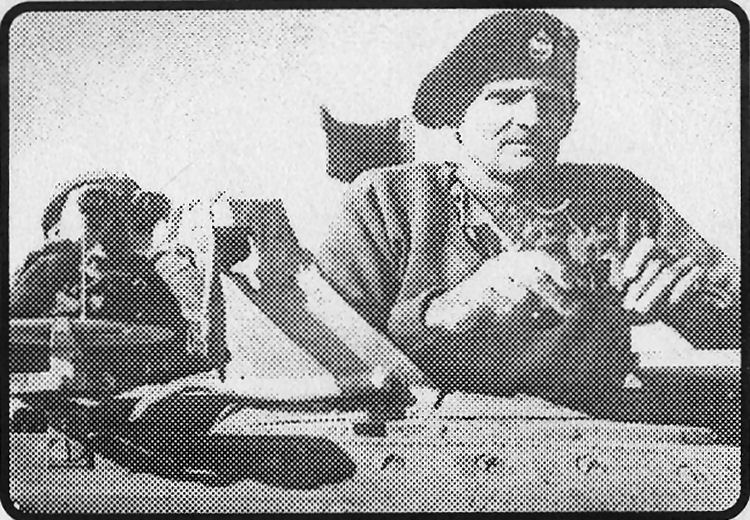Page Updated:- Sunday, 07 March, 2021. |
||||||||||
 From the Folkestone Herald Published 9 March 2000
Odeon secret. BRIAN Swoffer, of Wear Bay Crescent, Folkestone, was particularly interested in the recent reference in Memories to the building of the town’s super cinema, the Astoria - later re-named the Odeon - and said he thought the proprietor was Maestrani Ronco, who he understood was also the town’s Italian Consul. There were many local Italian caterers in those days, he recalled - Rossi, Cozzi, Grilli, /Ferrari (?) and Geronimo, to name a few. When the Herald photograph of around 1909 was taken Carlo Maestrani’s name appeared in large letters above Maestrani’s Central Cafe Restaurant. 
HUGE: The men sat on the top give some idea of the massive girders that were used to build Folkestone’s first ‘super cinema’ the Astoria - later, of course, re-named the Odeon, on the site of which Boots stands today. This picture was shown to me by local historian Alan Taylor after we published an Otto staff picture recently. The iron beam spanned the building, supporting the circle. The picture was taken in Oxford Terrace behind the cinema. Years ago I was shown a copy of the Montgomery picture, top right, which had been recovered from a local tip. I think it was probably a ‘still’ picture for cinema publicity when a “Desert Rats” film was showing.
But by the time the cinema was built Mr G. F. Ronco was the restaurant proprietor according to the book Picture Palaces Remembered, by John Roy and Tony Thompson, published in The Kellys street directory of 1938 gave the Italian Consul as Eugenio F. Ronco, so perhaps the writers got the first initial wrong. Incidentally on one occasion during the War the military took over the Astoria (which by then had become the Odeon) so that Desert Rats hero General Bernard Montgomery could speak to the officers under his command in the eastern district about the North Africa campaign ahead, amid very tight security. As Mr Swoffer points out the restaurant boss was very useful to the Astoria company as not only was he able to provide the site for the cinema but he also held a licence to sell drinks which he was able to pass on to the new company. In those days, he says, it was quite difficult to obtain a new licence. "A lot of local people, including my father, bought shares in the company. “The Odeon group were very helpful in the design of the cinema - and were very pleased with the result, as it was similar to their own new cinemas.
Closed shop! “What they did not tell the Astoria company, however, was that unless they belonged to a big group they were unable to obtain the best films, the distribution of which was like a closed shop! ‘As the Astoria could not get the films the Odeon “generously” said ‘we will take you over!’ - And obtained a cinema of their own design for a knockdown price. “But Astoria shareholders did not make a profit out of the deal - they may even have made a loss. “The only ‘dividend’ that my father got out of the deal was that on a Saturday morning before the cinema opened he was allowed to sit on the mighty £2,500 Compton organ as it rose up out of the pit!!’’ In Picture Palaces Remembered the authors, the late John Roy and Tony Thompson state that the architect/designer was Edward A Stone, well known for his four London Astoria cinema designs, particularly that at Finsbury Park, and he joined the board of Astoria (Folkestone) Ltd. The managing director and main driving force was Major C.H. Bell, the consulting engineer. The building cost £55,000, exclusive of site, and the total cost was given as £100,000, quite a tidy sum before the War. And, would you credit it today, the cinema once provided work for up to 43 people! And they were long hours too. The fire safety screen was said to weigh 6.5 tons! And there was an air conditioning system with complete air changes every 10 minutes. There was a capacity audience, filling 1666 seats for the grand opening night on April 20, 1935 the film being The Gay Divorce, starring that legendary pair Fred Astaire and Ginger Rogers. The film was preceded by a musical programme presented by Jan Godowsky and his orchestra and Leslie Holman at the Compton organ. In addition there was British Movietone News and the Gaumont British Magazine. The event was billed as the greatest show in Folkestone s history. By June 1936 the fast-growing County Cinemas Ltd had become the owners and according to John Roy and Tony Thompson the Astoria enjoyed good business. In 1939 County Cinemas merged with Oscar Deutsch’s circuit of cinemas and in June 1940 the Astoria - “The Cinema Supreme” - became the Odeon. The organ was later sold and is reputedly in Holland. I understand there was also an electronic Hammond Lafleur organ for music and dancing in the cinema’s restaurant/cafe.

Montgomery surveys the battle scene from his tank at El Alamein months after speaking to army officers in the Odeon about the coming North Africa campaign.
|
||||||||||
|
If anyone should have any a better picture than any on this page, or think I should add one they have, please email me at the following address:-
|
||||||||||
| LAST PAGE |
|
MENU PAGE |
|
NEXT PAGE | ||||||
